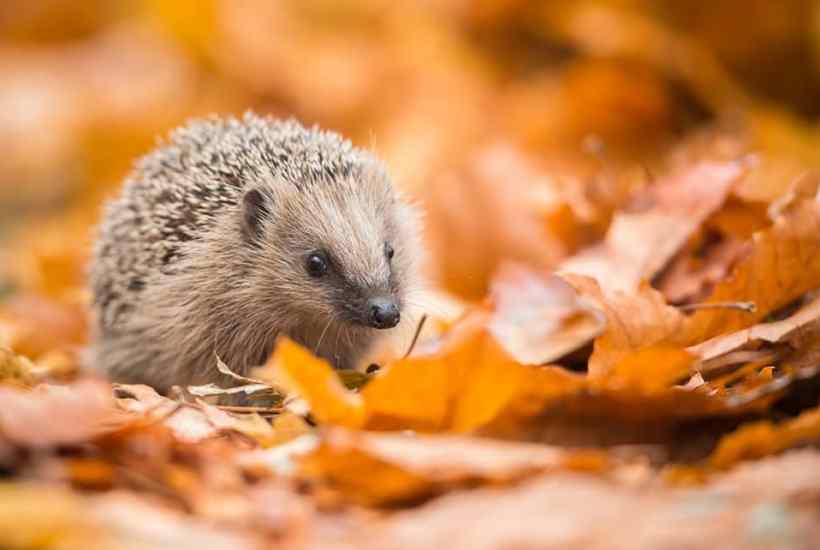Until last month I hadn’t seen a hedgehog for close to 30 years, though they were part of everyday life when I was a child. In the school holidays, we’d rush first thing to the nearby cattle grids to check for animals who’d fallen in overnight. It’s what passed for fun back then: picking damp critters out of concrete prisons.
Sometimes there were lambs, wedged in up to their woolly armpits; sometimes there were angry, pulsing toads. But it was hedgehog rescue that was our sacred duty. We’d pick them up in towels and take them to the hedgehog spa in the boiler room, where they’d spend the day lounging about eating chopped egg. Never feed a hedgehog milk. It gives them horrible diarrhoea.
That was the mid-1980s, and it was then that the hedgehog population began its steepest decline. By the mid-1990s, three quarters of what had once been an estimated population of 36 million had disappeared. In 2020, with fewer than a million left, they were declared at risk of extinction.
It was at that point that I put them in the mental box of things I choose not to think about, like bee decline and trafficked children. Roads are the biggest threat to hedgehogs and no one could or should ban cars. Nothing to be done. I resigned myself to not seeing a hedgehog again. I was wrong.
The first hog of the summer was one who fell on to the cover of my friend’s swimming pool. She appeared with him held in front of her on a dustpan and we gathered for a look. Most animals billed as cute are horrifying close up, their faces a mass of eyes or proboscises. This hedgehog was a beauty. He had silvery wings of fur around the eyes and a nose like a whippet. He crunched noisily through two jam-jar lids of damp dog biscuits and fell asleep under a shed.
The next hog I found meandering around mid-road in Northumberland, so I fetched a towel and moved it to safety. Numbers three, four and five were French. On holiday near Nantes, just a few days ago, sitting outside at night, there was a noise like a coffee percolator from under the garden table. After a while, a large hedgehog ambled into sight, hoovering up insects along the ridges in the decking. He paused briefly to sniff my foot and look me up and down, then carried on. Why are hedgehogs so unfazed by people? I have a theory that it’s to do with gardening and the hope of worms. Robins, who also enjoy a worm, are the most sociable of birds.
But why so many hedgehogs now? Is it the drought? The thought of thirsty hedgehogs forced out of hiding has brought back my urge to do something. But what? These animals are hard to help. They’re just so unsuited to the modern world. Weed killer, pesticides, slug pellets all do for them. Underneath their hovercraft skirts they have surprisingly long legs. A hog will travel for miles a night in search of food, crossing roads on which they’re eventually inevitably squashed. Curling up is a terrible defensive strategy for the 21st century. Robot mowers slash at them as they lie balled-up in the grass. Modern suburban man’s dream present is a hedgehog nightmare.
The only thing I can think to do for them is to risk the wrath of eco-fanatics and lend tentative support to badger culling. Badgers are a hedgehog’s sole predator in the UK wild. They’re mustelids, cousins of the sinewy, brutal wolverine, with the same long, curved claws. A badger will insert these claws between the spiny coat and the soft belly of a balled-up hog and scoop out its insides the way you might an avocado. I’ve come across the empty shell of a hedgehog before in badger country. It’s horrifying.
Badgers are intraguild predators, meaning they both eat hedgehogs and compete with them for food. It shouldn’t be surprising, then, that the selective badger cull, introduced to help stop bovine TB, has been helpful for hedgehogs. There are decent studies suggesting that where there was suitable habitat, the hedgehog population more than doubled over five years when badger numbers were controlled. Other studies show hedgehogs don’t forage nearly as widely in areas where there are badgers. One study mentions a ‘landscape of fear’. Poor sods. Just imagine having the Freddy Krueger of the animal world on your tail.
But badgers have friends in high places, including the erstwhile PM’s cuddly wife and her good friend Dominic Dyer, former chairman of the Badger Trust. Any suggestion that badgers might affect the hedgehog population and they create a landscape of fear of their own. Boris’s nickname for Carrie, it’s said, is ‘Little Otter’. Is this a show of mustelid solidarity? More likely it’s just the usual, exhausting animal proxy war. Green activists these days loathe farmers, not only because of pesticides or bad practice, but because of the very idea that the land should be owned or used to raise animals to eat. Most farmers see badgers as the enemy- – they churn up land, maul lambs and (perhaps) spread TB – so of course badgers are a cause célèbre for animal welfare groups.
Though the licence to cull badgers ends this year, campaigners insist that’s long overdue. They use special badger maths to make their case. ‘We can’t let half the UK badger population be eradicated,’ says the website of the Wildlife and Countryside Link. ‘The total number of badgers culled since the legal shooting began in 2013 is already around 140,000… So by the time the cull is finished over 50 per cent of the badger population may well have been killed.’ No it won’t. The population is stable even with the cull. During my cattle grid rescue years, badgers were in trouble, but they’re now an animal of least concern. It’s the hedgehogs that need help.
The only bright spot that I can see on the otherwise dismal political scene is that Liz Truss is a fan of hedgehogs. She wished them a happy Christmas from the Commons in 2015. It didn’t do much to revive their numbers, but it’s still somehow cheering.
Got something to add? Join the discussion and comment below.
Get 10 issues for just $10
Subscribe to The Spectator Australia today for the next 10 magazine issues, plus full online access, for just $10.
You might disagree with half of it, but you’ll enjoy reading all of it. Try your first month for free, then just $2 a week for the remainder of your first year.















Comments
Don't miss out
Join the conversation with other Spectator Australia readers. Subscribe to leave a comment.
SUBSCRIBEAlready a subscriber? Log in